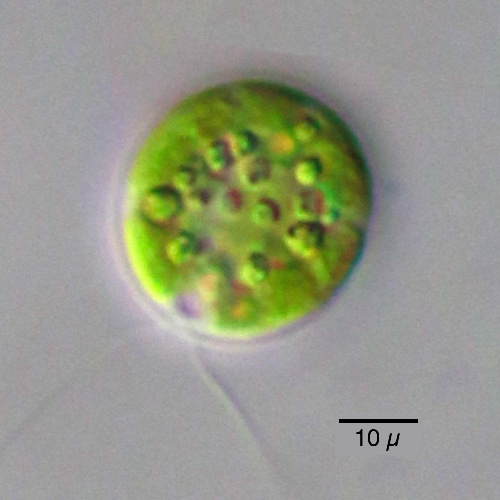Chlamydomonas TEM 07.jpg on:
[Wikipedia]
[Google]
[Amazon]


 ''Chlamydomonas'' is a genus of green algae consisting of about 150 speciesSmith, G.M. 1955 ''Cryptogamic Botany Volume 1. Algae and Fungi'' McGraw-Hill Book Company Inc of
''Chlamydomonas'' is a genus of green algae consisting of about 150 speciesSmith, G.M. 1955 ''Cryptogamic Botany Volume 1. Algae and Fungi'' McGraw-Hill Book Company Inc of

 ''Chlamydomonas'' is a genus of green algae consisting of about 150 speciesSmith, G.M. 1955 ''Cryptogamic Botany Volume 1. Algae and Fungi'' McGraw-Hill Book Company Inc of
''Chlamydomonas'' is a genus of green algae consisting of about 150 speciesSmith, G.M. 1955 ''Cryptogamic Botany Volume 1. Algae and Fungi'' McGraw-Hill Book Company Inc of unicellular
A unicellular organism, also known as a single-celled organism, is an organism that consists of a single cell, unlike a multicellular organism that consists of multiple cells. Organisms fall into two general categories: prokaryotic organisms and ...
flagellates, found in stagnant water and on damp soil, in freshwater, seawater, and even in snow as "snow algae". ''Chlamydomonas'' is used as a model organism for molecular biology
Molecular biology is the branch of biology that seeks to understand the molecular basis of biological activity in and between cells, including biomolecular synthesis, modification, mechanisms, and interactions. The study of chemical and physi ...
, especially studies of flagellar motility and chloroplast dynamics, biogenesis, and genetics. One of the many striking features of ''Chlamydomonas'' is that it contains ion channels (channelrhodopsins
Channelrhodopsins are a subfamily of retinylidene proteins (rhodopsins) that function as light-gated ion channels. They serve as sensory photoreceptors in unicellular green algae, controlling phototaxis: movement in response to light. Expressed ...
) that are directly activated by light. Some regulatory systems of ''Chlamydomonas'' are more complex than their homolog
In biology, homology is similarity due to shared ancestry between a pair of structures or genes in different taxa. A common example of homologous structures is the forelimbs of vertebrates, where the wings of bats and birds, the arms of prima ...
s in Gymnosperms, with evolutionarily related regulatory proteins being larger and containing additional domains.
Molecular phylogeny
Molecular phylogenetics () is the branch of phylogeny that analyzes genetic, hereditary molecular differences, predominantly in DNA sequences, to gain information on an organism's evolutionary relationships. From these analyses, it is possible to ...
studies indicated that the traditional genus ''Chlamydomonas'' as defined using morphological data was polyphyletic
A polyphyletic group is an assemblage of organisms or other evolving elements that is of mixed evolutionary origin. The term is often applied to groups that share similar features known as homoplasies, which are explained as a result of conver ...
within Volvocales
Chlamydomonadales, also known as Volvocales, are an order of flagellated or pseudociliated green algae, specifically of the Chlorophyceae.See the NCBIbr>webpage on Chlamydomonadales Data extracted from the Chlamydomonadales can form planar or ...
. Many species were subsequently reclassified (e.g., in ''Oogamochlamys
''Oogamochlamys'' is a genus of green algae in the family Chlamydomonadaceae.See the NCBI
The National Center for Biotechnology Information (NCBI) is part of the United States National Library of Medicine (NLM), a branch of the National Ins ...
, Lobochlamys
''Lobochlamys'' is a genus of green algae in the family Chlamydomonadaceae.See the NCBI
The National Center for Biotechnology Information (NCBI) is part of the United States National Library of Medicine (NLM), a branch of the National Insti ...
''), and many other "''Chlamydomonas''" s.l. lineages are still to be reclassified.
Description
All ''Chlamydomonas'' are unicellular organisms, spherical or slightly cylindrical, and a papilla may be present or absent. Chloroplasts are green and usually cup-shaped. Guiry, M.D., John, D.M. Rindi, F. and McCarthy, T.K. (ed) ''2007 New Survey of Clare Island Volume 6: The Freshwater and Terrestrial Algae''. Royal Irish Academy. A key feature of the genus is its two anterior flagella, each as long as the other. The flagellar microtubules may each be disassembled by the cell to provide spare material to rebuild the other's microtubules if they are damaged.Species
*''Chlamydomonas acidophila'' * ''Chlamydomonas caudata'' Wille * ''Chlamydomonas ehrenbergii'' Gorozhankin * ''Chlamydomonas elegans
''Chlamydomonas elegans'' is a species of freshwater green algae
The green algae (singular: green alga) are a group consisting of the Prasinodermophyta and its unnamed sister which contains the Chlorophyta and Charophyta/ Streptophyta. The ...
'' G.S.West 1915
* ''Chlamydomonas moewusii''
* ''Chlamydomonas nivalis
''Chlamydomonas nivalis'', also referred to as ''Chloromonas typhlos'', is a unicellular red-coloured photosynthetic green alga that is found in the snowfields of the alps and polar regions all over the world. They are one of the main algae resp ...
''
* ''Chlamydomonas ovoidae''
* ''Chlamydomonas reinhardtii
''Chlamydomonas reinhardtii'' is a single-cell green alga about 10 micrometres in diameter that swims with two flagella. It has a cell wall made of hydroxyproline-rich glycoproteins, a large cup-shaped chloroplast, a large pyrenoid, and an eye ...
''
Ecology
''Chlamydomonas'' is widely distributed in freshwater or damp soil. It is generally found in a habitat rich in ammonium salt. It possesses red eye spots for photosensitivity and reproduces both asexually and sexually. ''Chlamydomonass asexual reproduction occurs byzoospore
A zoospore is a motile asexual spore that uses a flagellum for locomotion. Also called a swarm spore, these spores are created by some protists, bacteria, and fungi to propagate themselves.
Diversity Flagella types
Zoospores may possess one or ...
s, aplanospore
{{Short pages monitor